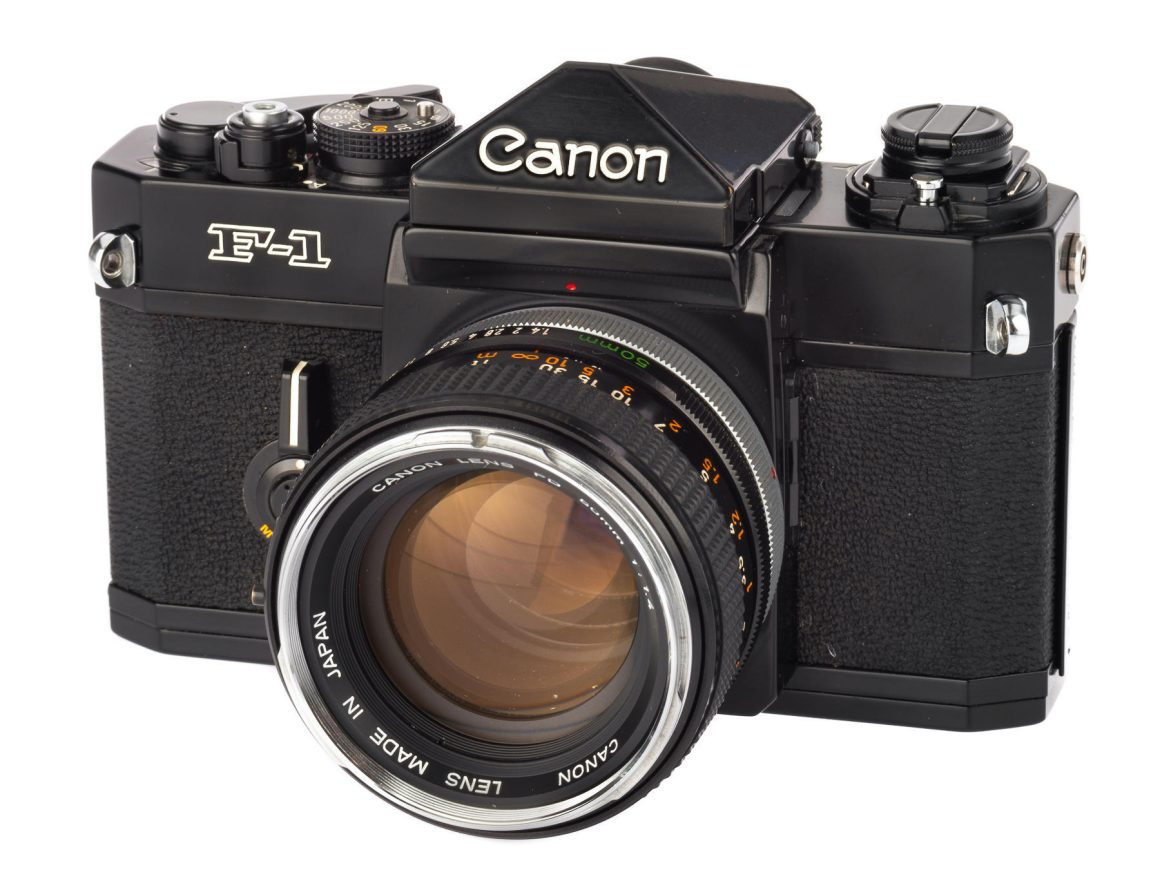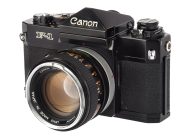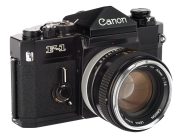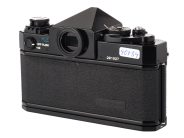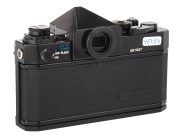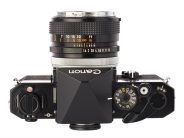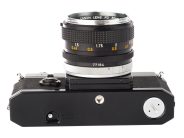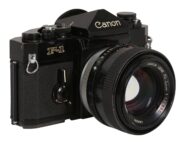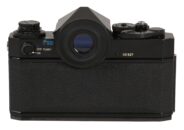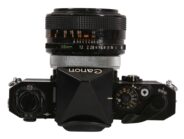Canon F-1
35mm MF film SLR camera • Discontinued
- Announced:
- · March 1971
- Production status:
- ● Discontinued
- Country of design:
- · Japan
- System:
- · Canon FD (1971)
Specification
| Format: | |
| 35mm full frame | |
Film type: | 135 cartridge-loaded film |
| Canon FD [42mm] | |
| Shutter: | |
Type: | Focal-plane |
Model: | Mechanical |
Speeds: | 1 - 1/2000 + B |
| Exposure: | |
Exposure metering: | Through-the-lens (TTL), open-aperture |
Exposure modes: | Manual |
| Physical characteristics: | |
Weight: | 820g |
Dimensions: | 146.7x98.7x43mm |
Manufacturer description #1
After five years and a large investment in money and labor, the top-of-the-line 35mm Canon F-1 system was born.
The FD lens mount was newly developed for the new line of FD lenses. The new lens mount enabled fully-coupled automatic exposure metering. The camera system also included the first accessory ever for remote picture-taking with the camera. The many accessories enabled seamless and instant compatibility.
The camera was built to endure 100,000 picture-taking cycles, temperatures ranging from -30 C to 60 C, and 90% humidity. Being a highly durable and reliable camera, the F-1 gained many followers including pros. Except for a one-time revision, the camera was manufactured and sold for ten years.
Manufacturer description #2
A Camera for All Seasons and Reasons
Summer, Fall, Winter, Spring. Arctic to tropical conditions. Anytime, anywhere. The Canon F-1 is ready to go where the pictures are.
Winter: There are plenty of picture-taking possibilities for a photographer with the right camera. One that will still operate when the weather really gets cold. How about using a motor drive on the ski slopes to catch all the action? Or would you like to photograph snow crystals through a microscope? It's easy with the F-1.
Spring: The season of new awakenings. In you as a photographer and in the earth around you. Flowers are starting to bloom. Of course you want to capture all this beauty, and you can with a Canon. Use the new FD 100mm macro lens or FD 50mm macro lens. By using with the life-size adapter, close-up photography of wild-life can be taken with the magnifcation of from 1/2 up to life-size.
Summer: Sports car races. Combine the Servo EE Finder with a 100-200mm zoom lens. You can focus and crop your shots in the camera while exposures are set for you automatically. Now you can concentrate on all the color and excitement of the event without worrying about missed shots. Campfires. Everyone is sitting around the fire roasting marshmallows. Use a Canon electronic flash unit and a Flash-Auto Ring on your standard 50mm or 35mm wide-angle lens to get perfect shots everytime. Focus on the faces, and they will be properly exposed. Not many other flash systems can guarantee that kind of performance outside at night.
Fall: The time of the year for breath-taking sunsets. Start shooting with the camera's accurate built-in exposure meter. After the sun sets, switch over to the meter in the optional Booster T Finder to catch the radient afterglow. When the harvest moon appears, you can continue shooting, because the Booster T Finder can read down to EV-5.5 with an ASA 25 film. That means long exposures of 60 seconds at f/1.2! The meter in this fantastic finder is the world's most sensitive TTL (through-the-Iens) meter.
Now that you have discovered the creative possibilities which photography has to offer, you need a camera which can keep pace with you. One that can transform your experiences into reality. Anytime during the year. The Canon F-1 is just this type of camera. The camera for all seasons and reasons.
Viewing and Focusing Flexibility
The name of the game in SLR photography is viewing and focusing. One of the main reasons for the widespread popularity of the SLR is that the image you see through the viewfinder is the same as the image recorded on the film. Viewing, focusing and composing become simple matters. There is no problem using a 500mm lens with an extremely small angle of view of only 5° or in taking life-size close-ups with a macro lens, because what you see through the lens is what you get.
But not all focusing screens work equally well with all lenses. Canon has solved this problem by giving you a choice of nine interchangeable focusing screens for the F-1 camera.
Professional-Quality Exposure Measurement
Nowadays, all built-in exposure meters for cameras read light coming through-the-Iens (TTL), and most measure it with the lens at full aperture. But Canon is the only camera that uses a Central Area System for exposure measurement, too. Don't mistake the Central Area System for a center-weighed one, because it's different. In Canon's method, a 12 percent center portion is the only part of the picture area measured by the meter, and this portion is clearly indicated by a slightly darkened rectangle which does not interfere in the least with focusing or viewing. The Central Area System is employed to give the photographer two options, that of using the meter like an averaging type or like a true spot meter. The Central Area is large enough for the fast-shooting photographer simply to meter the main subject and get a reliable reading; yet it is small enough to allow the most exacting worker to meter small areas in the picture very accurately so as to ensure highlight or shadow details. Backlighting is no problem at all, because the metering area is clearly defined. Under all kinds of lighting conditions, the Canon F-1's Central Area System gives the photographer complete control over his exposures.
Automatic Exposure Control
When the action becomes fast and furious, there is usually not enough time to think about exposure. You are too busy following the subject, focusing and composing. When this is the case, just detach the Eye-Level Finder of the F-1 and attach the Servo EE Finder in its place. Immediately you have an automatic camera, one that sets the proper exposure for you quickly and accurately. You select the shutter speed depending on the amount of action you want to "freeze" or on the focal length of the telephoto lens you are using, and a special servo motor adjusts the diaphragm of the lens to the proper aperture. Central Emphasis Metering is employed in the Servo EE Finder to ensure good exposures in the majority of cases. In this type of system the entire picture area is read by the meter, but additional weight is given to the center where the main subject is likely to appear.
Dim-Light Photography
When the light grows dim, the Canon F-1 really starts to shine. Simply replace the Eye-Level Finder with the Booster T Finder, and now you can meter the faintest light through-the-Iens, even the light from the full moon. This incredible unit takes all the guesswork out of nighttime photography. It even times your long exposures for you electronically up to 60 seconds at ASA 25! There is no need for a cable release as the shutter is held open automatically for you while a blinking light on top of the finder indicates the number of seconds of the exposure. Nothing could be easier.
When the lens-to-film plane distance is increased with bellows or extension tubes to produce extreme magnifications in macro work or when the F-1 is used on a microscope, the light reaching the film becomes quite dim indeed. In this case, the Booster T Finder is the only way to get accurate TTL meter readings.
A Choice of Three Motor Drives
Motor drives have become quite popular in recent years, because they offer two distinct advantages. One advantage is rapid film advance. In the "Single" mode of operation, the film is automatically advanced to the next frame immediately following each individual shot. Therefore, the camera is always ready to use, and you never have to bother with advancing the film manually. The second advantage is sequence photography. In the "Continuous" mode, a rapid succession of photographs may be taken in bursts usually up to three or four frames per second (fps). You can capture fast action at its peak or analyze it in sequential form frame by frame. The most significant pose of a fashion model and the fleeting expression of a child may be recorded without missing the shot. Or an athlete's form can be studied step by step.
A motor drive is not only convenient and fun to use, but is indispensable for photojournalism, sports, and wildlife photography where quick response is essential.
Canon makes a total of three (that's right, three) motor drives for the F-1! All three use Canon's reliable two motor system: one motor to advance the film and a separate motor to release the shutter. Both the Motor Drive Unit and the Motor Drive MF are easily attachable to any F-1 camera without modification. Simply remove the camera's bottom cover and screw the motor into the tripod socket. The third motor drive is permanently built into the bottom of a modified F-1 body. This unit, including the body, motor and separate battery pack is called the High Speed Motor Drive Camera.
The Motor Drive Unit is a moderately priced, versatile accessory having many uses, including industrial and scientific applications. It has a built-in intervalometer which doubles as a handgrip underneath the camera. A total of eight shooting intervals ranging from one frame per minute to three per second are available. Either cord or cordless battery cases housing 10 penlight batteries (Size AA) can be used.
The Motor Drive MF is a recent addition to the Canon line and is perfect for hand-held action photography with its handgrip mounted on the front right side. Following suggestions from sports and news photographers, Canon designed a compact motor with a detachable handgrip (which also serves as the battery case for ten penlight cells) and made the intervalometer an optional accessory. In the "Continuous" mode, 3 1/2 fps may be shot at shutter speeds from 1/60 to 1/2000 sec. No mirror lock-up is required. When the accessory Interval Timer L is plugged into the side of the MF, nine rates from two fps to one frame every three minutes are available. Other accessories such as a self-timer, extension cord and remote switch extend the Motor Drive MF's range considerably.
Designed especially for the 1972 Sapporo Winter Olympic Games, the High Speed Motor Drive Camera is the rapid action photographer's dream come true. A semi-transparent stationary reflex mirror has been borrowed from the Canon Pellix camera and installed in a modified version of the F-1. A special high speed motor is permanently built into the bottom of the camera and is powered by 20 penlight cells ina separate battery pack. Both single frame and continuous shooting from four to nine fps are possible. Even at 9 fps, continuous uninterrupted viewing is possible right through the camera's viewfinder. The mirror never needs to be locked in the upward position. Fantastic!
Extended Shooting Capacity
Using a motor drive is a fast way to shoot and a sure way to use up a lot of film. A continuous burst will use up a 36 exposure roll in a little over ten seconds.
Suppose you're covering a championship fight. You've got to be ready to capture that crucial knockout blow if and when it occurs. But at 3 or 3 1/2 fps, you might run out of film before the end of the first round.
In this situation, the Film Chamber 250 is the answer. This specially designed unit is attached to the F-1 camera in place of the regular back cover. It permits 250 exposures of uninterrupted shooting using about 33 feet of bulk film. The Film Chamber 250 contains two Film Magazines 250, one on the left side of the camera for supply and the other on the right for take-up. When you run out of film, there is no rewinding. Just close the light traps on both magazines, and open the back cover. Remove the take-up magazine. Then transfer the empty supply magazine to the take-up side. Drop in another bulk loaded magazine, thread the film, and you're ready to shoot another 250 exposures. Immediately.
The exact length of film needed for 250 exposures can be pre-loaded into a magazine using the Canon Film Loader 250.
Match-Needle Flash Photography
Canon has developed an entirely new solution to the old problem of achieving correct exposures in electronic flash photography - it's called the CAT (Canon Auto Tuning) System.
With manual flash units, you have to make complicated calculations using guide numbers, whereas automatic sensor-type units do not work well outside at night or whan there is a large foreground object between you and the subject.
In the CAT System, the focused distance of the lens as well as the charging level of the flash unit's capacitor are transmitted as electrical signals to the F-1's metering system which then determines the position of the meter needle inside the viewfinder. To obtain proper exposure, just turn the aperture ring to match the aperture needle with the meter needle and shoot. It's as easy as normal daylight photography.
At present, four FD lenses - two standard 50mm lenses, the f/1.8 and the f/1.4, and two 35mm wide-angles, the f/3.5 and the f/2 - can be used with the CAT System when the Flash-Auto Ring A2 or B2 is bayonet mounted to the front of lens.
The compact Canon Speedlite 133D is a shoe mounting unit which couples directly to the F-1 via the Flash Coupler L. It has a guide number of 30 (ASA 25 in ft.) and uses four penlight batteries.
A Complete Line of Accessories
With a complete line of accessories for close-ups, macrophotography, and photomicrography, you too can capture the magic of the world in close-up with the F-1. Exotic flowers, strange insects and intricate watchworks all take on new meaning.when photographed at close range.
One of the easiest ways to enter this exciting field is with the fabulous FD 50mm f/3.5 S.S.C. Macro lens. It has an extra long helicoid which permits continous focusing from infinity down to 1/2 life size. With the addition of the Life Size Adapter, focusing down to 1: 1 is possible. A t this reproduction ratio, the subject area of the photograph is the same size as the 35mm frame, that is 24 x 36mm. You can fill the frame with just the center part of an orchid, while Super Spectra Coating ensures perfect color fidelity of its delicate shades even in backlit situations.
The newly developed Macro Lens FD 100mm f/4 S.C. offers the photographic magnification of up to 1/2 life size while the combined use of the Extension Tube FD 50 offers the photographic magnification ranging from 1:1 to 1/2 life size.
Since this macro lens has a focal length twice as long as the standard lens, photographs can be taken at a considerable distance from the subjects. This is highly effective for shooting plants, animals and insects which you cannot very easily approach and for the subjects requiring flash photography.
Another way to take close-ups is by using a bellows unit. The Bellows FL is a solidly built accessory which can be used between the F-1 body and any Canon lens for extreme macro work. With a standard 50mm lens mounted on the Bellows FL, magnifications up to approximately 3X are possible. Focusing and magnification adjustments can be made at the subject side or the camera side of the bellows, while the entire unit plus camera can be moved back and forth with a separate control. Semi-automatic diaphragm control is possible when the lens is mounted in the normal position. When a standard lens is mounted on the bellows in the reverse direction (using the Macrophoto Coupler FL55), you lose diaphragm automation, but it's possible to obtain up to 4X magnifications of your subject.
Canon has other accessories for taking close-ups, including Canon Close-up Lenses, Extension Tube FL 15 and FL 25, the Extension Tube M set and Bellows M.
"Photomicrography" means taking pictures through a microscope. Instead of using the camera lens, the microscope's optics are used to form the image. There are two accessories for coupling the F-1 to the microscope of your choice. The Photomicro Unit F attaches the F-1 directly to the microscope sleeve and permits 1/2 magnification of the microscope's image, whereas the Microphoto Hood must be used in conjunction with the Lens Mount Converter A, and a bellows and copy stand but can provide up to full size magnification.
For slide copying, Canon makes the Slide Duplicator FL which is used with the Bellows FL and a standard or macro lens in making up to 1:1 duplicate slides.
Copying pictures or diagrams from all types of printed materials is a cinch with either of Canon's two copy stands, the lightweight Handy Stand F or the sturdy Copy Stand 4 having a baseboard and upright post with a camera holder.
Canon also makes it own filters, cable releases, and gadget bags.
If you purchase the Canon F-1, you are not buying just another camera, but one having a total system of interchangeable parts and accessories built around it. As your involvement grows in photography and your interests change, the F-1 is ready and willing to keep pace with you. It's as flexible as your creative spirit and as wide ranging as your ideas. Without special weatherproofing, the F-1 can operate in temperatures from -4° to + 140° F. The Canon F-1 is truly a camera for all seasons and reasons. Your camera. From Canon.
Manufacturer description #3
Type : 35mm single-lens reflex camera with focal plane shutter. Picture size : 24 x 36mm.
Interchangeable Lenses : Canon FD series lenses with aperture signal lever.
Standard Lens : Canon FD 55mm F 1.2, FD 50mm F 1.4, FD 50mm F 1.8.
Viewfinder : Removable pentagonal prism viewfinder. Interchangeable with Servo EE Finder, Booster T Finder, Speed Finder, Waist-Level Finder.
Viewfinder Attachments : Angle Finder B, Magnifier, Dioptric Adjustment Lenses, Eyecup.
Focusing Screen : Using Fresnel lens, standard focusing glass with microprism screen rangefinder and three other interchangeable types. With metering beam-splitting condenser.
Field-of-View : 97% of actual picture area. 0.77X with standard 50mm lens at infinity.
Finder Information : Meter needle and aperture needle, outside shutter speed coupling range indicator, fixed dot for stopped-down metering use and battery check mark, shutter speed scale, metering limit marks.
Dioptric Adjustment Lenses : Standard -1.2 diopter (R-1). Interchangeable with R+3, R+2, R+1, R0, R-2, R-3, and R-4.
Mirror : Quick return mirror with shock-absorbing mechanism. Mirror can be fixed in upper position. Aperture is manually operated when mirror is fixed in upper position.
Lens Mount : Bayonet type FD mount. FL and R series of lenses mountable.
Function : FD lenses ; Full aperture metering, coupled with automatic diaphragm. FL lenses ; Stopped-down metering, coupled with automatic diaphragm. R lenses ; Stopped-down metering, manually operated diaphragm.
Shutter : Focal plane shutter using super thin titanium screen. Designed for elimination of functioning noise. Shutter release button can be locked.
Shutter Speed Dial : Single shaft non-revolving type with shutter scales and ASA film speed scales. Two coupling pins for setting attachments are provided.
Shutter Speeds : B, 1-1/2000. Multiple series. Equiinterval index. X contact at "60".
Film Speed Scale : ASA 25-2000.
Self-Timer : Built in. Activate with shutter release button. Approx. 10 sec. time lag. Self-timer lever is used in common as stopped-down functioning lever.
Exposure Adjusting Mechanism : Built in. Using CdS photocell. Coupled to shutter speeds, film speeds and f/stop. Match needle type TTL full aperture metering mechanism. Center-spot metering system, measures 12% of picture area. Stopped-down metering possible. Fixed dot type metering using stopped-down functioning lever. Locking of the lever possible.
Exposure Meter Coupling Range : With ASA 100 film, EV2.5 (f/1.2 at 1/4 sec.)-EV 18 (f/11 at 1/2000 sec.). Meter information window turns red when outside of coupling range.
Meter Battery : One 1.3 V M20 (#625) mercury battery used.
Battery Checker : Built in. Check at ASA 100, shutter speed at 1/2000 sec.
TTL Full Aperture Metering System EE : Uses exclusive Servo EE Finder and Battery Case in combination. Full aperture metering with FD lens. Shutter priority type EE. Functioning range ; with ASA 100 film, EV 2.5 (f/1.2 at 1/4 sec.)-EV 18 (f/11 at 1/2000 sec.).
Ultra-low Illumination Metering : Metering possible, with ASA 100 film, between EV 15 (f/22 at 1/60 sec.) and EV-3.5 (f/1.2 at 15 sec.) with use of exclusive Booster T Finder.
Synchronized Flash : FP and X contact. Automatic time lag adjusting type.
Flash Socket : On side body. Two contacts on film rewind knob for flash circuit for directly connected adapter, and meter circuit.
Canon Auto Tuning (CAT) System : Diaphragm control by recharge completion signal and focusing distance signal. Proper aperture is established by the meter matching needle system through the connection of the Speedlite 133D, Flash Auto Ring, Flash Coupler L and prescribed FD 50mm F 1.4, FD 50mm F 1.8, or FD 35mm F 2 lens.
Synchronizing Range : FP class ; 1/2000-1/125 sec. and 1/30 sec. or under. Speedlite ; 1/60 sec. or under. M, MF class ; 1/30 sec. or under.
Film Loading : With multislit film spool.
Film Winding : Short-stroke winding possible. Single operation 180° winding lever. Play ; 15°.
Film Rewinding : Performed by rewind button and crank.
Double Exposure : Possible by operating film rewind button.
Back Cover : Crank pull-up type. Removable for Film Chamber 250.
Bottom Cover : Motor Drive Unit can be attached after removing bottom cover.
Frame Counter : Self-resetting type activated by opening back cover.
Accessory Shoe : Exclusive. Flash Couplers D, L, and other couplers can be attached.
From the Popular Photography magazine (January 1971)
Photokina '70
Canon's show-stealing F-1 SLR system was launched in Cologne with no less that 25 lenses, 16 of which are either completely new, or thorough redesigns of previous models. Those preceded by "FD" provide full-aperture exposure reading with the Canon F-1; the others employ the stop-down method.
7.5-mm Fisheye f/5.6 (circular-free 180-degree images), FD 17-mm f/4 (distortion-free 104-degrees), FD 24-mm f/2.8, TS 35-mm f/2.8 AL, FD 35-mm f/2, FD 55-mm f/1.2 AL, FD 85-mm f/1.8, FD 100-mm f/2.8, FD 135-mm f/2.5, FD 200-mm f/4, FD 300-mm f/5.6, FD 55-135-mm Zoom f/3.5, FL 400-mm f/5.6, FL 600-mm f/5.6, FL 800-mm f/8, FL 1,200-mm f/11.
Canon F-1 special editions (1)
- Canon F-1 "Montreal 1976 Summer Olympics" - July 1976
